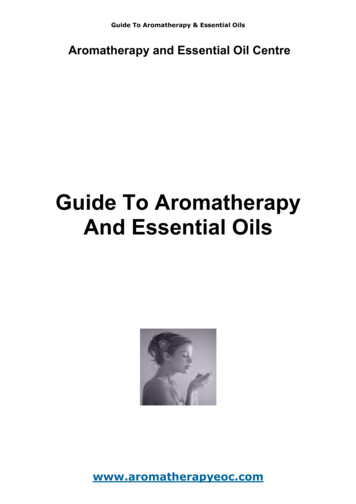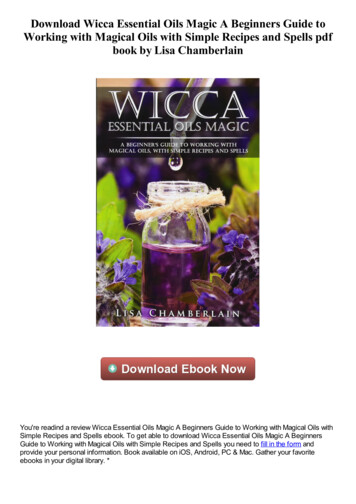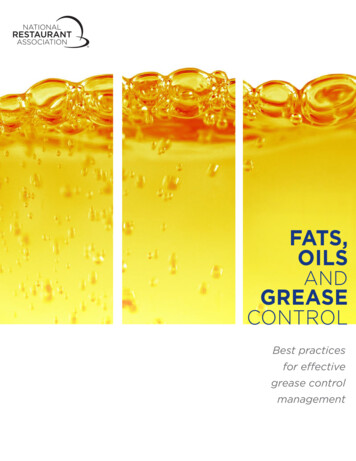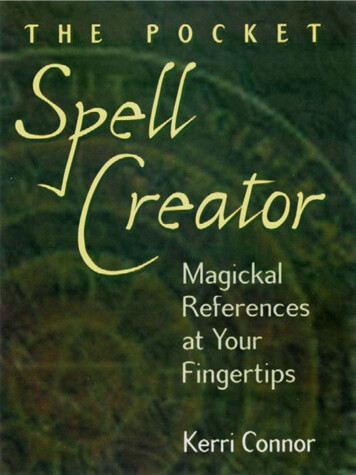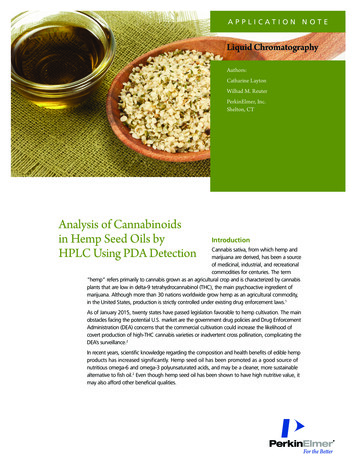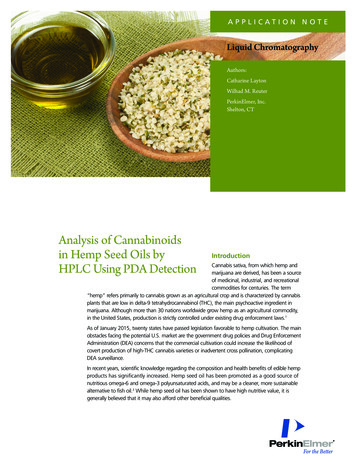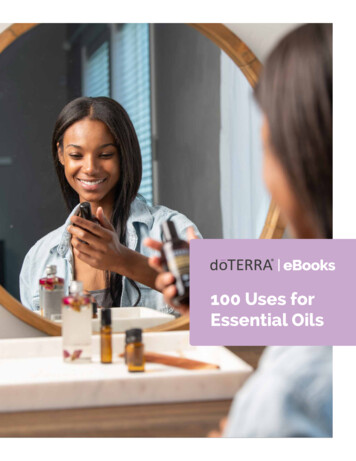
Transcription
100 Uses forEssential Oils
100 Uses for Essential OilsIntroductionSolve YourProblems withEssential OilsWe face dozens of problems everyday. We want to feel our best andhelp our families do the same.We worry about health issues, having a clean and safehome, meeting the demands of a busy schedule—the listof worries goes on and on. Many of the problems we faceare simply a result of being human. However, we live in anage where we have the power to take control, the power tosolve our problems.Essential oils are more than just another product on themarket. Essential oils are problem-solvers. They’re naturalgifts at our disposal that can help us solve many of thethings we worry about on a daily basis.We can use essential oils to feelour best. We can use them to keepour homes clean and safe fromenvironmental threats.We can even use them to solve seemingly simple problemslike helping children with their bedtime routine. Though youmight have a long list of worries, there’s an equally longlist of essential oils and ways to use them to solve yourproblems. We don’t need to settle for generic solutions—we've been given all the tools we need from Mother Nature.We don’t need to give up on our mission to protect ourfamilies and keep them strong—we already have the naturalsolutions we need to care for others.2
100 Uses for Essential OilsWhat makes essential oils so powerful? First, essentialOnce you understand that high-quality essential oils areoils are extremely versatile. Some people think thatuseful in our modern day, you’re then ready to put theiressential oils are used merely to make things smell nicepotency and power to the test. The more you learn aboutor to make a massage more enjoyable. The truth is thatwhat essential oils are, how they work, and how they canessential oils have countless uses for everyday life—manybe used safely, the more they can become a helpful part ofof which you might have never thought of. While someyour daily life.people know essential oils are useful for such things asaromatherapy and purifying the air, others are shockedto learn that essential oils can also be used for cooking,personal hygiene, household cleaning, promoting a restfulenvironment for sleep, and much more.When used properly, essential oils can become, quiteliterally, an “essential” part of your routine. Whether youcare deeply about using natural solutions in the home, wantproducts that will support your efforts in living a healthylifestyle, or just want a powerful and effective way toNot only are a wide variety of essential oils available, butsupport the well-being of your family, essential oils can helpeach individual oil also provides a unique set of benefits,to fulfill your needs.making the possibilities for use and application practicallylimitless. With so many options, you can customize youressential oil usage to fit your personal preferences and dailyneeds, giving you and your family the solutions you’ve beenlooking for.Are you ready to see all that essential oils have in storefor you? Keep reading to learn about the wide world ofessential oils and all they have to offer, plus 100 ways to usethem. And remember, these 100 uses are just the beginningof your journey through the exciting world of essential oils!Have you ever used Peppermintessential oil?Peppermint is a perfect example of how asingle essential oil can be used for dozensof tasks. For instance, Peppermint promoteshealthy respiratory function and feelings ofclear breathing when taken internally.* Inaddition, ingesting Peppermint oil can alsohelp promote digestive health. When appliedto the skin, Peppermint can help naturallyrepel insects. Adding a drop of Peppermint toyour toothbrush can help freshen your breath.Putting a drop of Peppermint in your water ortea will give it a minty flavor, plus provide aneasy way to experience the internal benefitswe just talked about. Want to add mint flavorto baked goods or other recipes? Peppermintcan be used for that too. And when you needa little pick-me-up in the middle of the day,simply placing a drop of Peppermint oil in thehand, rubbing your palms together, and inhalingthe energizing aroma will do the trick. We justnamed seven uses for Peppermint, and that’sonly the beginning. Peppermint is just oneexample of a powerful oil—there are hundredsof essential oils at your fingertips that haveequally impressive uses and benefits.3
100 Uses for Essential OilsChapter oneAromaticUseWhether you’re brand new toessential oils or consider yourselfan expert, aromatic applicationis one of the simplest and mosteffective application methodsavailable. If you use an essentialoil aromatically, that means youexperience the aroma of the oilthrough the air.Due to the potent, powerful nature of essential oils, you canexperience the benefits of aromatic use right away, as theoil disperses through the air quickly and effectively.If you’ve ever opened a bottle ofessential oil and held it under yournose, you know how powerful it can be.Opening a bottle of Douglas Fir essential oil might instantlyremind you of camping trips you took in the mountains asa kid. Unscrewing the cap on a bottle of Cinnamon Bark oilmight make you think of Christmastime or other favoriteholidays. Inhaling the aroma from a bottle of Wild Orangeoil might make you think of eating oranges in the summer.When you breathe in the aroma of essential oils, yourmemories and past experiences come together to create aunique experience that’s a little different for everyone.4
100 Uses for Essential OilsDiffusingNot only is aromatic use simple and convenient, but it’s also useful forpurifying the air and promoting a calm, inviting, or uplifting environment.So, what is the best way to take advantage of the aromatic benefits ofessential oils?Diffusing oils using an essential oil diffuser is perhapsthe easiest way to experience essential oils aromatically.Essential oil diffusers can be found in millions of homesaround the world. This is because the simple act of addingessential oils to a diffuser and turning it on can transform anentire space. It can make the house feel clean when you’reexpecting company, help the family wind down at bedtime,promote an energizing atmosphere to enjoy while studyingfor a test or during your kids’ homework time—you getthe idea. It seems simple, but this is how essential oils cantransform your space, your day—and by extension—your life.Several models of diffusers are available, and your choice indiffuser will depend on your needs and preferences when itcomes to using essential oils. For example, are you hopingto diffuse essential oils over a large area? Do you plan to useyour diffuser to purify the air in your home? Do you want adiffuser that’s easy to move from room to room? While eachessential oil diffuser will provide different features, mostcan be categorized as either water diffusers or waterlessdiffusers. Water diffusers use water to disperse essential oilsthrough the air in a fine mist, while waterless models diffusethe oil straight into the air.No matter what type of diffuser you choose,you’ll want to make sure that it preserves thepotency of the essential oils. Any diffuser thatuses heat or other elements that can change thechemical structure an oil will be less effective.If you’ve never used a diffuser before, don’tworry, it’s easy. Here are a few best practices tokeep in mind when diffusing essential oils.5
100 Uses for Essential OilsDiffuser TipsAvoid placing your diffuser in directsunlight or near a fan. The heat fromthe sun could alter the chemicalstructure of your oils, and air blowingfrom a fan could make your diffusionless effective.The amount of oil used and durationof diffusion will depend on the size ofthe room, placement and output of thediffuser, and air turnover in the room. Ifyou’re wondering how much oil to useand how long to diffuse for, a goodrule of thumb is to start with a smallamount and work your way up fromthere as necessary.Be sure to clean your diffuser regularly,according to the manufacturer’sinstructions (this includes a deepcleaning at least once a month)to avoid any oil buildup that coulddamage the diffuser or make diffusingless effective.When cleaning your diffuser, try to usenatural cleaning agents, like water andvinegar. It’s also a good idea to unplugthe device before cleaning.Whether you’re using a diffuser to enjoy your favorite essentialoils, or finding other creative ways to breathe in the pure aroma ofoils, plenty of options exist when it comes to aromatic use. Let’sgo over the first 10 of our 100 uses for essential oils with 10 ideasfor aromatic use.6
100 Uses for Essential OilsHow to use essentialoils aromatically1Combine several of your favorite essential oilsin a diffuser to create a custom diffuser blend.Use one to three drops of each oil.2To promote clean, fresh air in your car, place afew drops of essential oil on a cotton ball andwedge it into the air vents.4To help create a peaceful, relaxing environmentfor your family before sleep, diffuse essentialoils with calming aromas while your childrenbrush their teeth, read bedtime stories, and getready for bed. Try Clary Sage, Lavender, Melissa,dōTERRA Balance , or dōTERRA Serenity .3When you want to enjoy the aroma ofessential oils throughout the day, combinea few drops of your favorite oil with waterin a spray bottle and spritz the mixture onyour clothing to keep the scent with you forseveral hours.5Diffuse essential oils with invigorating andenergizing aromas at your work desk duringthe sluggish afternoon hours. Try Grapefruit,Lemon, Spearmint, Spikenard, Tangerine, ordōTERRA Motivate .7
100 Uses for Essential Oils6Keep the aroma of essential oils with youwhile on the go by creating your ownaromatherapy jewelry. Placing a few drops ofoil on clay beads typically works best.8Place a diffuser nearby for a delightful aromawhen you’re doing homework or importantprojects, studying for tests, or working fromhome. Try Basil, Douglas Fir, Peppermint, orInTune .7Diffuse during your morning routine to giveyour day an uplifting, invigorating start. TryEucalyptus, Wild Orange, Peppermint, CitrusBliss , or Elevation.9When you’re expecting company, diffuseessential oils to produce a fresh and invitingaroma throughout the home. Try Bergamot,Lavender, Lemon, or Purify.10Improve the aroma and environment of anyspace by taking your diffuser with you to hotelrooms, conference rooms, your office, the car,the classroom, or anywhere else that couldbenefit from the power of essential oils.8
100 Uses for Essential OilsChapter twoTopical UseWhile you might think thatpeople only use essentialoils topically to help improvethe skin, there are actuallydozens of other reasons fortopical use—including onesyou might not have thought oflike promoting feelings of clearbreathing, targeting areas oftension through massage, andeven repelling insects.Yes, essential oils have incredible benefits for theskin, but topical use stretches beyond a glowingcomplexion. Once you learn how to topically applyessential oils safely and correctly, you’ll be surprised bythe far-reaching benefits you’ll experience.Much like aromatic use, topical application of essential oilsis a relatively simple method that allows you to experiencetheir benefits both quickly and effectively. One of thegreatest benefits of using essential oils topically is that youcan target specific areas of the body to achieve a specificdesired effect. Additionally, you’ll enjoy the aroma of theessential oil for several hours as it absorbs into the skin.Before we get too deep into howto use essential oils topically, let’sdiscuss a few safety guidelinesthat will help you to get the mostout of your essential oils, whileensuring the protection of your skin.9
100 Uses for Essential OilsSafety guidelines fortopical useWhen applying any type of product to your skin (essentialoil or otherwise), it’s important to understand how to use theproduct and be aware of how it may react with your skin orbody.For example, before you use a new moisturizer, facialcleanser, or other topical product, you probably look atKnow that some essentialoils should always be dilutedbefore topical applicationdue to their strong chemistry.Remember to always dilute thefollowing oils with a carrier oilbefore putting them on yourskin in order to avoid sensitivity:the back of the bottle to read the instructions and makesure you’re using it correctly. You might even glance atthe ingredients to make sure the product doesn’t containanything you know would irritate your skin. You would alsoprobably pay attention to any warnings (such as “Keepproduct out of eyes”) to make sure you don’t cause anyharm to your body. The same goes for essential oils. Beforeapplying an essential oil topically, consider a few things.DilutionOne way to ensure the safe use of essential oils—and evenprolong the effects of topical use--is through dilution.While some people worry that diluting an oil takes awayits potency or power, it actually extends the benefits of theessential oil by increasing absorption into the skin. The bestway to dilute an essential oil before topical application is tocombine it with a carrier oil like Fractionated Coconut Oil.For dilution, the best ratio is typically 10 drops of a carrier oilto one drop of essential oil.Keep in mind, this isn’t an exhaustive list, and manyoils may need to be diluted based on your personalskin sensitivity. Make sure to read the label cautionsprior to using any essential oil product.10
100 Uses for Essential OilsDosage and sensitivityWhen you’re first starting with topical application, one of the first questionsyou’ll probably have is, “How much essential oil should I be using?”If you’re using an essential oil topically for the first time, it’is wise to start with the smallest possible dose: one to twodrops. It’s also best to start with a diluted oil to see how itwill react with the skin. From there, you can see how yourskin reacts and increase the dose in the future (if necessary).Each person will experience every essential oil a littledifferently, so if the oil you’re currently using isn’t deliveringthe results you were hoping for, you can always apply adifferent essential oil with a similar chemistry.Keep in mind that essential oils are extremely potent, sowhen it comes to topical application, it’ is best to applyseveral small doses throughout the day as opposed to asingle large dose. Typically, essential oils can be appliedtopically every four to six hours as needed.Each person has different sensitivities, skin conditions,preferences, and health concerns, which is why it’s possiblefor essential oils to cause a sensitivity response. Those withsensitive skin may be more likely to develop a sensitivityand should always be cautious when using essential oilstopically. It’ is also important to note that children have farmore sensitive skin than adults, so essential oils shouldalways be diluted before applying on children and extrasafety precautions should be taken to avoid sensitivity.The best way to ensure safe topical use is to alwaysfollow instructions and guidelines for a particular oil anduse dilution as a way of protecting the skin and helpingabsorption.Remember, your skin is delicate. When applying essentialoils topically, use the same judgment that you would beforeputting any other product on your skin.Start small, adjust the amount ofproduct if necessary, and always be gentle.11
100 Uses for Essential OilsSun sensitivityIt’s important to note that some essential oils, particularlycitrus oils, can cause sensitivity when exposed to sun orultraviolet light after topical application. Because citrus oilshave photosensitive compounds, exposure to sunlight, UVlight, or sunlamps at least 12 hours after application cancause sensitivity for the skin. Essential oils that pose a riskfor sun sensitivity will typically include a warning or caution,so be sure to carefully read oil labels before application.If you plan to spend a day at the beach, play with your kidsat the park, or participate in any other outdoor activitieswhere you’ll be exposed to the sun, make sure to planaccordingly. Keep in mind that most citrus essential oilscause photosensitivity, but other oils and essential oilblends have been known to pose a risk as well. Readinglabels before application will help you avoid issues withphotosensitivity.Essential oils known to causephotosensitivity include:Keep in mind, this isn’t an exhaustive list. Other blends andproducts can also pose a risk for photosensitivity, so be sureto read the label cautions prior to using any essential oilproduct on the skin.12
100 Uses for Essential OilsSo how do you know if you needto make adjustments beforeapplying an essential oil topically?Every dōTERRA essential oil approved for topical useincludes a skin sensitivity descriptor to help anyone usingthe oil to understand the best way of applying the oil forsafe use. Each product approved for topical use will includeone of the following labels:NNeat: If something is labeled Neat, it means that the essentialoil can be applied without any dilution. Oils in this group tend tohave a mild chemistry and thus a low risk for sensitivity.DDilute: If something falls under the classification Dilute, itshould be diluted with a carrier oil every time before topicalapplication. These oils have a stronger, more potent chemistryand can be safely enjoyed after dilution.SSensitive: Oils labeled Sensitive should always be dilutedbefore using on young or sensitive skin. Be sure to pay attentionto this label if you already know that you have sensitive skin or ifyou plan to use the oil on a child.Thankfully, the more you use essential oils, the more you’llunderstand dilution, what kinds of oils your skin respondsbest to, and more. Once you’re ready to safely applyessential oils topically, here are 10 ideas to get you started:13
100 Uses for Essential OilsHow to use essentialoils topically11Use essential oils topically to cleanse the skinor promote a healthy-looking complexion. TryBergamot, Frankincense, Tea Tree, or any ofthe HD Clear skincare products.12Apply essential oils like Eucalyptus,Peppermint, or dōTERRA Breathe topicallyto the chest to promote feelings of clearbreathing and create an invigorating vapor.14Apply essential oils to the abdomen for asoothing abdominal massage.13If you work at a desk all day, target areas oftension by applying soothing oils to the neck,temples, shoulders, or hands.15Rub essential oils that are known for naturallyrepelling insects on the wrists and anklesbefore going on a hike. Try Geranium,Lemongrass, or Thyme.14
100 Uses for Essential Oils16Combine essential oils with FractionatedCoconut Oil to give yourself a soothingscalp massage. Oils like Lime, Tea Tree, orRosemary work well for this.18For occasional skin irritations, apply one totwo drops of essential oil to the affectedarea. Consider using Lavender, Tea Tree, orCorrect-X for this.17Apply essential oils to the abdomen duringyour menstrual cycle when you want tocreate a comforting massage.19Add your favorite essential oil (or oils) tounscented lotion and apply to your skin toexperience topical benefits.20Use dōTERRA Spa Lip Balm to help hydrate andsoothe your lips throughout the day.15
100 Uses for Essential OilsChapter threeInternalUseOver the years, there’s been muchdebate over the internal use ofessential oils. Just like any otheressential oil application method,internal usage can absolutelyserve as a safe way to enjoyessential oils when used correctly.After all, you’ve probably used vitamins or supplements fortheir internal benefits. Plus, did you know that small amountsof essential oils can be found in some of the foods we eat?Our bodies are ready to metabolize essential oils—the key isusing the correct oils in safe amounts.When applied safely and properly, internaluse of essential oils can be just as beneficialas aromatic and topical use.In some cases, internal use can provide unique benefitsthat the other two application methods simply cannot offer.Though some are skeptical about the efficacy of internaluse, research supports the potential benefits of consumingessential oils internally. Among many benefits, essential oilscan be used internally to support gastrointestinal health,maintain healthy immune function, promote healthy cellfunction, provide the body with internal cleansing benefits,and more.* In addition to these internal benefits, essentialoils can also be used to add flavor to food and beverages,providing a creative way to consume oils for internalbenefit.* We’ll talk about some of the ways to use essentialoils for cooking in the next chapter.16
100 Uses for Essential OilsSafety guidelines forinternal useIt’s important to note that some essential oilsletter I has been deemed safe for internal use.are never safe for internal use because of theirRemember, even if an essential oil is consideredchemistry. Each dōTERRA essential oil includessafe for internal use, the proper applicationapplication guidelines, using the symbols A, T,methods and dosage must be adhered to in orderand I, which stand for “Aromatic,” “Topical,” andto stay within the realm of safe usage.“Internal.” Any dōTERRA product marked with theSingle essential oils that should never be used internallyin any amount include:By always reading the label before using an essential oil product andchecking for the “I” symbol, you can be sure you aren’t using essentialoils that have been deemed inappropriate for internal consumption.17
100 Uses for Essential OilsStrong oilsDosageIf you’re using an essential oil with a strong chemistry,Before consuming any amount of essential oils internally, beyou can simply adjust your application method. Typically,sure to consider your health status or any personal healthessential oils like Cassia, Cinnamon Bark, Clove, Cumin,conditions. It may be necessary to speak with your physicianOregano, and Thyme are considered strong oils that shouldfirst. When you have considered your health needs, keep innot be placed on the tongue or in the mouth directly.mind that an appropriate dose of internal application will bedifferent for each person based on their health status, age,Remember in the last chapter when we talked about alwayssize, and the oil itself.diluting certain essential oils before applying them to theskin? Well, the same goes for using some of these strongWhen you’re ready to use essential oils internally, it’soils internally. To alter the application method, try adding thebest to start with the smallest dose possible—one to twooil to a veggie capsule and swallowing, or placing one dropdrops. From here, you can increase the number of dropsof the oil in at least four ounces of liquid. It’s also safe toif necessary. Beyond a certain point, increasing the doseplace one to two drops of these oils into recipes in order towill no longer add benefit, and taking too much can bedisperse the oil before consumption.potentially harmful for the body. It is better to take smallerdoses and repeat the dose every 4–6 hours as needed.Lower daily doses are recommended when using anessential oil internally over an extended period of time,rather than isolated accounts.Here are 10 ideas to help you get started with internal use of essential oils.18
100 Uses for Essential OilsHow to use essentialoils internally21Add one or two drops of essential oil toa glass of water or veggie capsule to aiddigestion.* Try Black Pepper, Cardamom,Cassia, Cilantro, Coriander, Fennel, Ginger, orDigestZen .22Add essential oils like Cinnamon Bark orLemon to tea or hot water and drink slowly tosoothe the throat.*24Did you know that the internal use of certainessential oils can help support cardiovascularhealth? Take essential oils and essential oilproducts like Cardamom, Cassia, Coriander,Ginger, Marjoram, Petitgrain, or xEO Mega internally to support a healthy cardiovascularsystem.*23Take essential oils like DDR Prime or PinkPepper internally to help promote cellularhealth.*25When you need immune support, try takingessential oils like Basil, Black Pepper, Cassia,Fennel, Lime, or dōTERRA On Guard Beadlets internally.*19
100 Uses for Essential Oils26Some essential oils may be taken internallyto promote restful sleep.* Try Lavender ordōTERRA Serenity Restful Complex Softgels.28Essential oils may be used internally topromote healthy organ function.* Try JuniperBerry or the Zendocrine Detoxification Blendfor this.27Use essential oils like Lavender or BlackPepper internally to help ease anxiousfeelings.*29Some essential oils may provide internalcleansing benefits.* Consider using CelerySeed, Juniper Berry, Tangerine, or Lime.30Use essential oils like Basil, Coriander,Lavender, or Bergamot internally to providesoothing comfort to the body.**These statements have not been evaluated by the Food and Drug Administration.This product is not intended to diagnose, treat, cure, or prevent disease.20
100 Uses for Essential OilsChapter fourCookingWhether you’re tired of thesame old recipes or want to takeadvantage of the internal benefitsessential oils have to offer, cookingwith essential oils is a great wayto make your meals more flavorfuland interesting.Because essential oils are so potent, it only takes a smallamount of essential oil to add powerful flavor to any foodor drink. When only one drop (or less) is required to createintense flavor, using essential oils for cooking becomes asmart, cost-effective solution.Your essential oil bottle will last muchlonger than other ingredients that mayonly survive for a week in the fridge.This also makes essential oils a convenient option foradding flavor to your food. When you realize you’re out oflemons or don’t have any fresh rosemary for your recipe, allyou have to do is go to your essential oil collection for help.Another benefit of using essential oils for cooking is thatwhen used properly, you can have peace of mind aboutputting safe, natural ingredients into your food. You alreadyknow that many essential oils offer benefits to the body whenconsumed internally, so adding essential oils to your recipesmay help you reap these benefits in a fun, delicious way.21
100 Uses for Essential OilsSafety guidelines forcooking with essential oilsBefore you begin cooking with essential oils, it’simportant to know the safety and usage guidelinesfor each oil. Remember, not all essential oils areapproved for internal use, so there are someThe toothpick methodessential oils you want to avoid putting in your food.See Chapter 3 for a list of single essential oils thatThe best way to determine how much essential oilshouldn’t be used internally—and always rememberto add to your food is by starting small. You can startto read labels carefully before consuming anyadding essential oils to a recipe using the toothpickessential oil.method, which is done by placing the tip of a toothpickinto the essential oil bottle and then mixing it into theHow do I know how muchessential oil to add to my food?batter, marinade, soup, sauce, or mixture of whateveryou’re cooking. This is a simple way to add a smallamount of oil without the risk of ruining your dish withtoo much flavor.When it comes to measuring essential oils forcooking, you’ll want to consider several factors. Theamount of oil you add to your food will depend onthe particular oil you plan to use; your own tastepreferences; whether you plan to substitute theessential oil for raw, fresh, or dried ingredients; theamount of food you’re making; and more.Adding one dropFor example, if you’re making a large pot of soup,If you’re using essential oils with a milder chemistry orthere are some cases where it would be appropriateto add an entire drop of oil. However, if you’re usingan oil with a particularly strong flavor, one dropcould be too much. When making smaller batchesof food—like homemade salad dressing, sauces,cooking a large amount of food, it may be appropriateto use an entire drop of oil. It’s a good idea to use anoil dropper or place the oil drop on a spoon first ratherthan straight in the dish in order to avoid adding too much.or dips—using an entire drop of oil could ruin thedish with overpowering flavor. So how do you knowhow much oil to add when cooking? Here are a fewguidelines that can help.Adding several dropsIt’s important to know that, when cooking with heat,much of the essential oil can evaporate or bake out.More than one drop of essential oil can be added tofood when you’re cooking with heat or baking andwant to preserve the flavor. Several drops may alsobe necessary if you’re cooking a large batch of food.It might be a good idea to add a drop of oil, do a tastetest, and then decide if you need more oil.22
100 Uses for Essential OilsBest practices for cooking withessential oilsCooking with essential oils is easier than you think.When you’re ready to start using essential oils inthe kitchen, here are a few best practices to keep inmind as you get the hang of it. Remember to only cook with essential oils thathave been approved for internal use. Use stainless steel, ceramic, or glass cookware, assome essential oils can damage certain types ofplastic. Because essential oils are affected by heat, youcan add extra oil to a recipe before baking orboiling. However, in some cases, the flavor can stillevaporate or cook out. If possible, add the oil atthe end of your cooking to preserve the flavor. Remember to start small—only a small amountof oil will be needed for powerful flavor. You canalways add more later, but you can’t take theflavor out once it has been added. Always use the toothpick method when addingessential oils with a strong chemistry such asCassia, Cinnamon Bark, Clove, Cumin, Thyme,or Oregano. These oils should also be properlydiluted when added to beverages.Now that you understand the basics, let’s go over10 easy ways to use essential oils for cooking
home, meeting the demands of a busy schedule—the list of worries goes on and on. Many of the problems we face are simply a result of being human. However, we live in an age where we have the power to take control, the power to solve our problems. Essential oils are more than just another product on the mar
